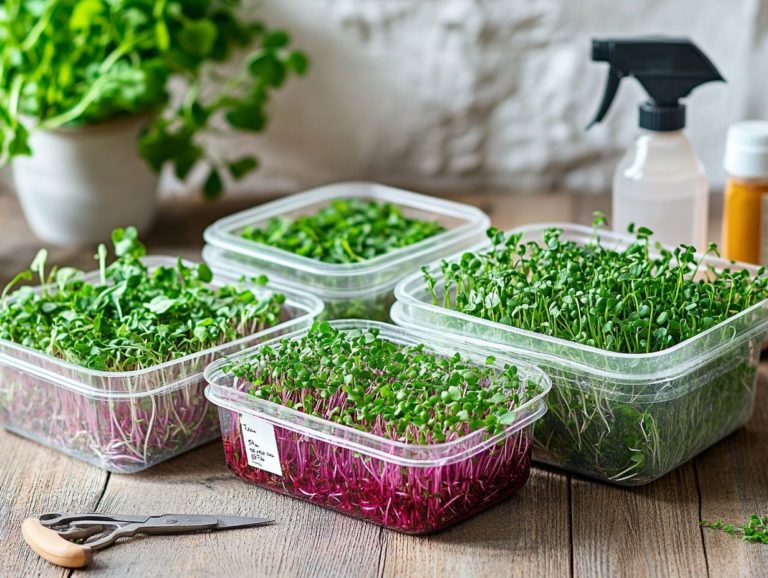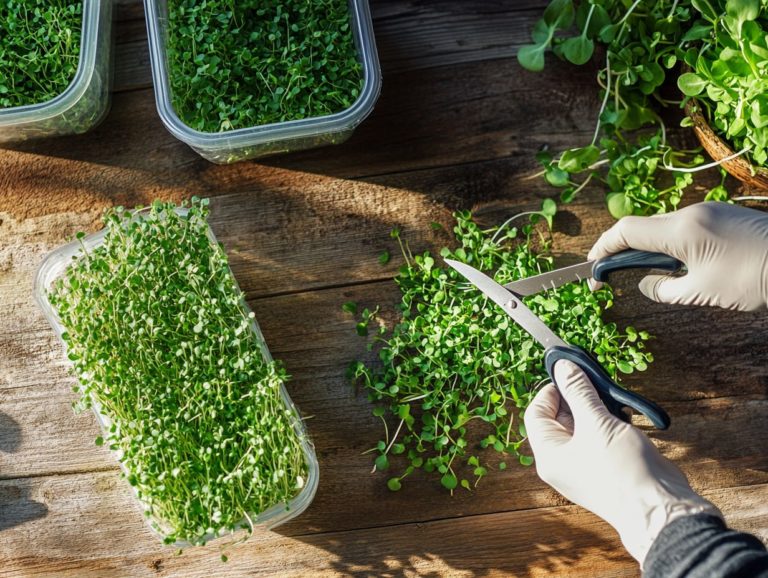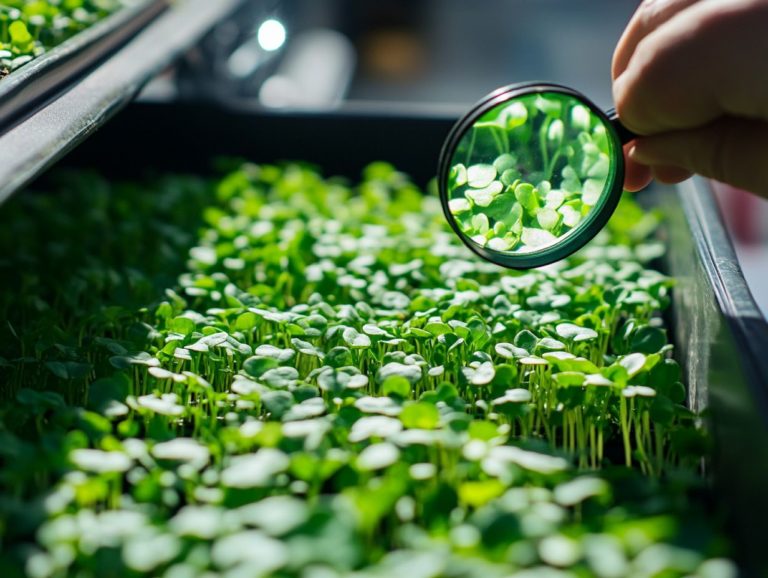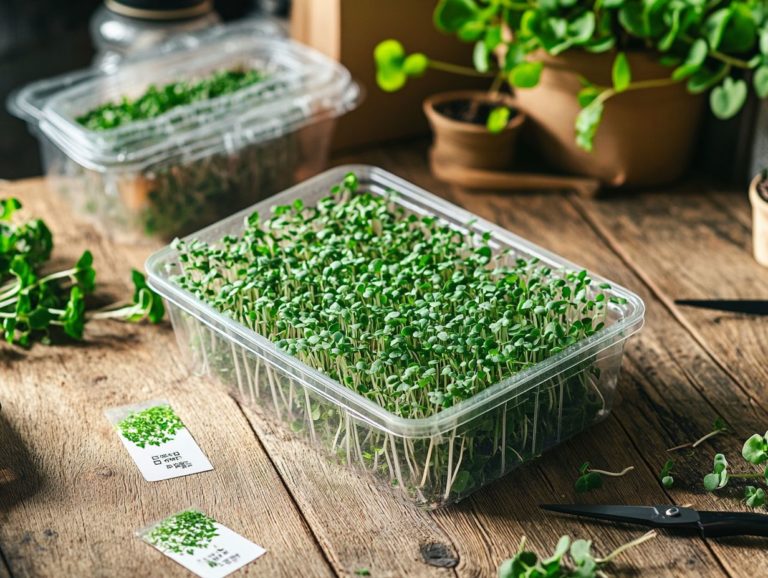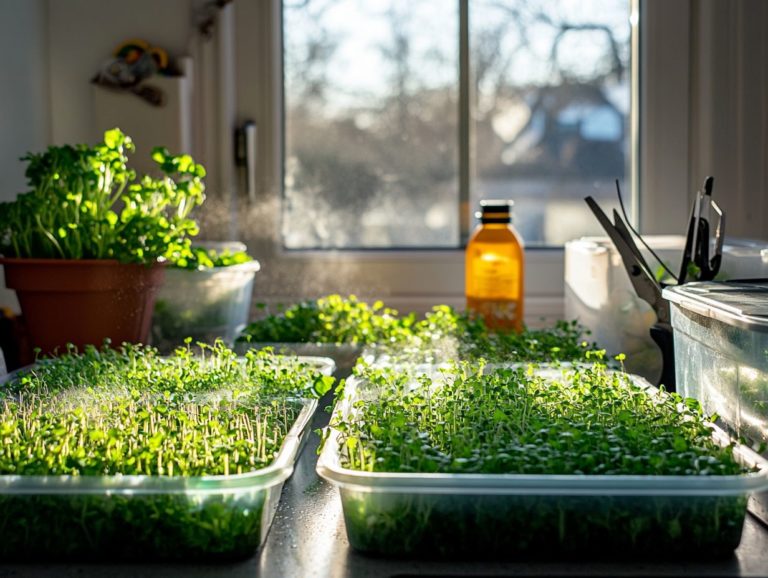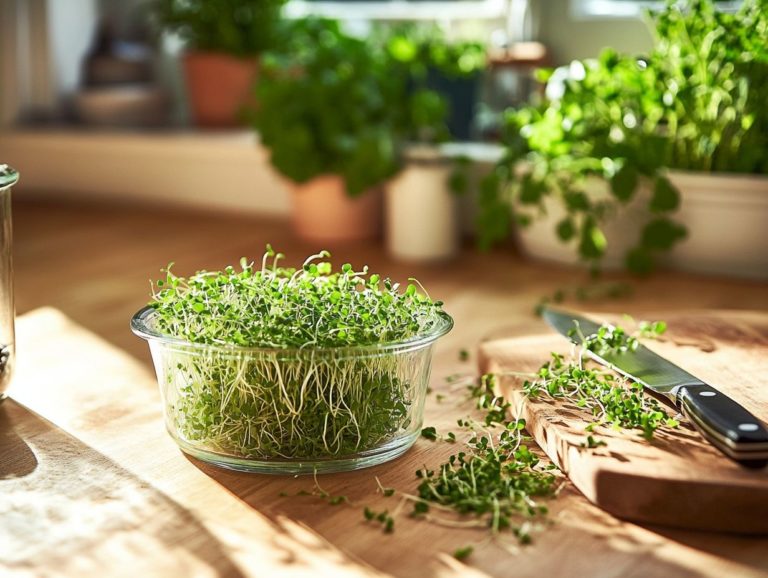Harvesting Microgreens for Cooking: A Guide
Microgreens are not just a trendy garnish; they are packed with flavor and nutrients that can transform your dishes!
Explore the world of microgreens, from their various types to the remarkable benefits they bring to both your health and your culinary endeavors.
You ll find a step-by-step guide to harvesting your own microgreens, along with essential tips for a successful growing experience and effective methods for storing them to keep their freshness intact.
Prepare to elevate your cooking with these vibrant little greens!
Contents
Key Takeaways:
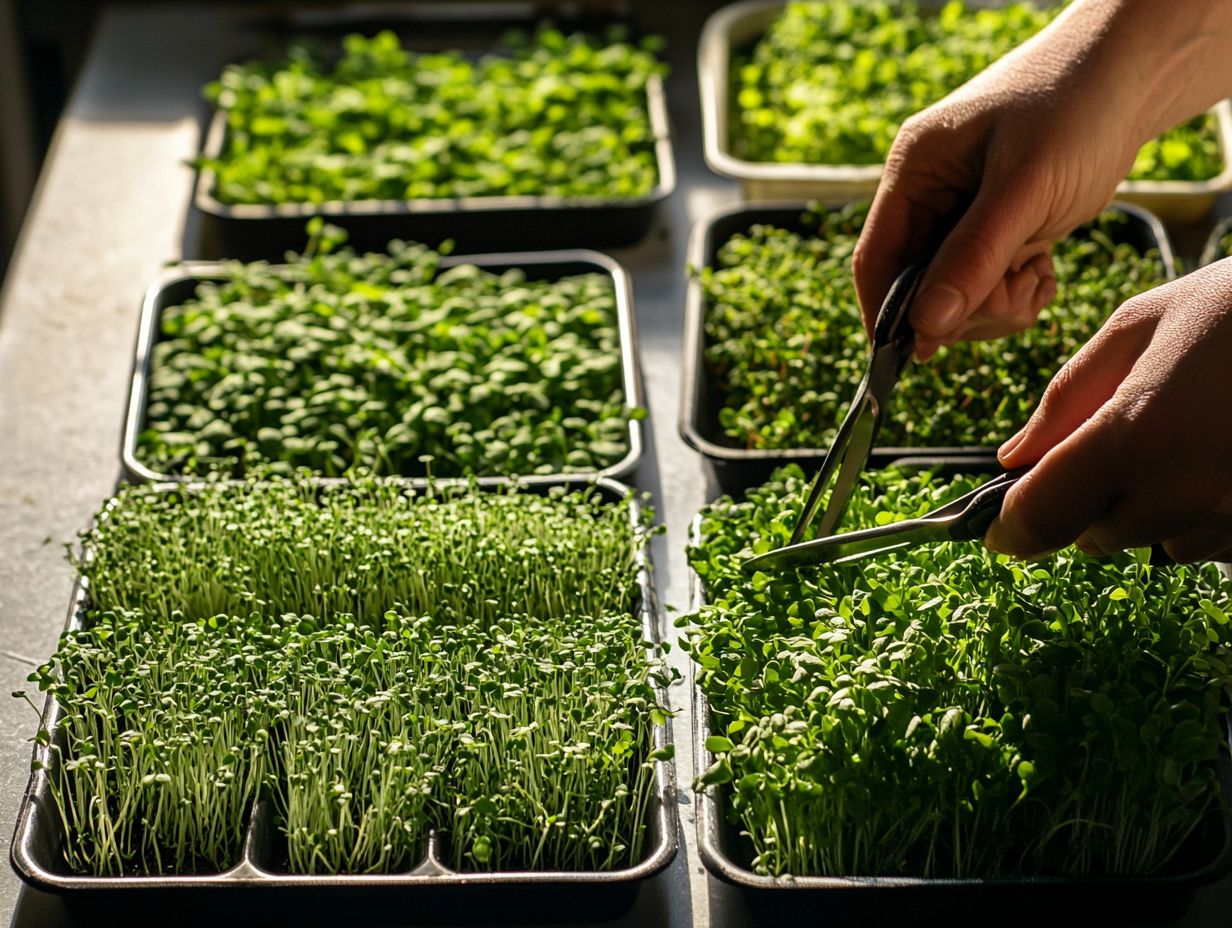
- Microgreens are young, nutrient-dense plants that are harvested just a few weeks after germination.
- Not only do microgreens add flavor and texture to dishes, but they also provide a plethora of health benefits due to their high vitamin and mineral content.
- To properly harvest microgreens, use sharp scissors and cut just above the soil level, making sure to only harvest what you will immediately use.
What are Microgreens?
Microgreens are young, edible plants harvested right after their first true leaves emerge, providing an exquisite burst of flavor, nutrition, and vibrant color. Typically grown in soil or through hydroponic systems a method of growing plants in water without soil they can be cultivated from a variety of seeds, including radish, kale, arugula, broccoli, and pea.
Not only are microgreens remarkably easy to grow at home, but they also elevate your culinary creations, serving as a nutritious addition to salads, smoothies, and garnishes. If you’re interested in starting your own, check out this guide on how to start a microgreen garden for beginners. It’s no wonder they’ve become a favored choice among chefs and home cooks alike.
Definition and Types
Discover popular varieties like radish, kale, arugula, and broccoli, each contributing distinct tastes and textures that can elevate everything from simple salads to gourmet entr es. Microgreens come in a delightful variety, offering unique flavors and culinary applications.
Beet greens add a subtle sweetness and vibrant color, making them a favored garnish or a standout in colorful grain bowls. Pea shoots bring a crisp texture and a fresh, green flavor, making them a perfect addition to stir-fries or a delightful topping for sandwiches.
Then there’s basil microgreens, which pack a flavorful punch with their aromatic essence, ideal for brightening up a plate of pasta or adding depth to pesto. Other gems like cilantro microgreens can enhance your salsas or tacos, while sunflower microgreens offer a nutty crunch, perfect for wraps or salads. To learn more about boosting your harvest, check out how to maximize yields from microgreens.
Each type not only elevates the visual appeal of your dishes but also boosts their nutritional content, providing essential vitamins and minerals that support a healthy lifestyle.
Benefits of Growing and Eating Microgreens
Growing and consuming microgreens offers an array of advantages that elevate your culinary experience. Not only do these vibrant, nutrient-rich plants enhance your nutritional intake, but they also amplify flavors in your dishes, making gardening accessible even to those with limited space.
Varieties like radish and kale are powerhouses of nutrition, enriching your diet with essential vitamins, minerals, and antioxidants often missing in processed foods. Don’t miss out on the chance to enhance your meals with microgreens! Embracing them is a delightful way to foster health and elevate your meals.
Start your journey today and enjoy the immediate benefits of fresh, flavorful microgreens in your cooking!
Nutritional Value and Culinary Uses
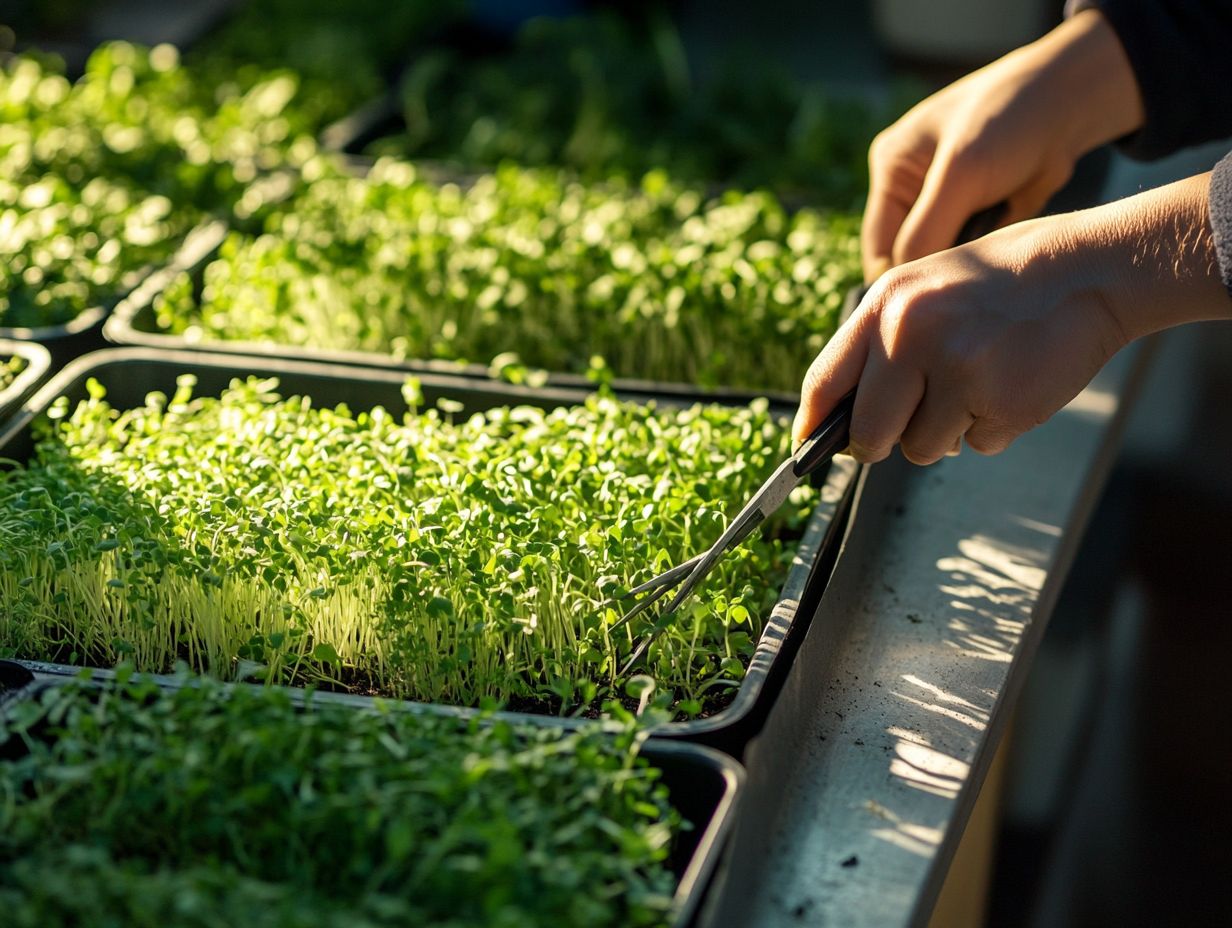
Microgreens are celebrated for their impressive nutritional profiles. They offer a wealth of vitamins, minerals, and antioxidants that can significantly enhance your overall health. Their culinary versatility is remarkable, allowing them to shine in various dishes. From fresh salads to savory entrees, they add not only flavor but also a vibrant burst of color.
For example, broccoli microgreens are packed with sulforaphane, a compound in broccoli known for its health benefits. Radish microgreens deliver a delightful peppery kick that can elevate even the simplest sandwich. If you’re interested in growing your own, check out this guide on how to grow microgreens in your kitchen. These tiny greens don’t just offer nutritional power; they also introduce a variety of textures and flavors to your meals, making each bite an adventure.
Think about tossing a handful of basil microgreens into your pesto for an unexpected twist. You can also adorn a creamy avocado toast with fresh pea shoots for an added layer of freshness. The combinations are truly limitless, inviting you to unleash your culinary creativity and embrace healthy eating in your everyday life.
How to Harvest Microgreens for Cooking
Harvesting microgreens for your culinary creations is a remarkably simple process. It enhances their flavor and nutritional advantages, transforming them into a delightful addition to your dishes.
By following a few straightforward steps, you can expertly gather these tender greens. This ensures they retain their vibrant colors and textures, perfect for elevating salads, garnishes, and an array of other enticing recipes. For those interested in growing microgreens more efficiently, learning How to Use Hydroponics for Microgreens can be beneficial.
Step-by-Step Guide
To effectively harvest microgreens, start by pinpointing the optimal moment for harvesting. This is typically when the plants reach a height of two to three inches, proudly displaying their vibrant colors and flavors. With clean, sharp scissors in hand, delicately snip the greens just above the soil line. Ensure that the remaining plants are left to flourish for future harvests.
Next, take a moment to assess the overall health of your microgreens. Confirm they remain free from pests and diseases. Keep your growing area clean for safe and healthy microgreens.
After cutting, handle the greens with utmost care to avoid bruising. This can impact both flavor and shelf life. It’s wise to wash the harvested greens thoroughly and store them in a moisture-controlled environment to retain their delightful taste and freshness.
Timely harvesting not only enhances flavor but also extends the lifecycle of your growing operation. This allows for multiple harvests from the same batch.
Tips for Growing and Harvesting Microgreens
Successfully cultivating and harvesting microgreens demands a harmonious blend of knowledge and hands-on experience. It’s essential to grasp key factors like soil quality, sunlight exposure, and effective watering techniques.
By adhering to best practices and avoiding common pitfalls, you can relish the vibrant flavors, delightful textures, and nutritional benefits that these young greens provide. For those interested in growing their own, a step-by-step guide to sowing microgreens can be invaluable, whether you are a novice or a seasoned gardener.
Best Practices and Common Mistakes
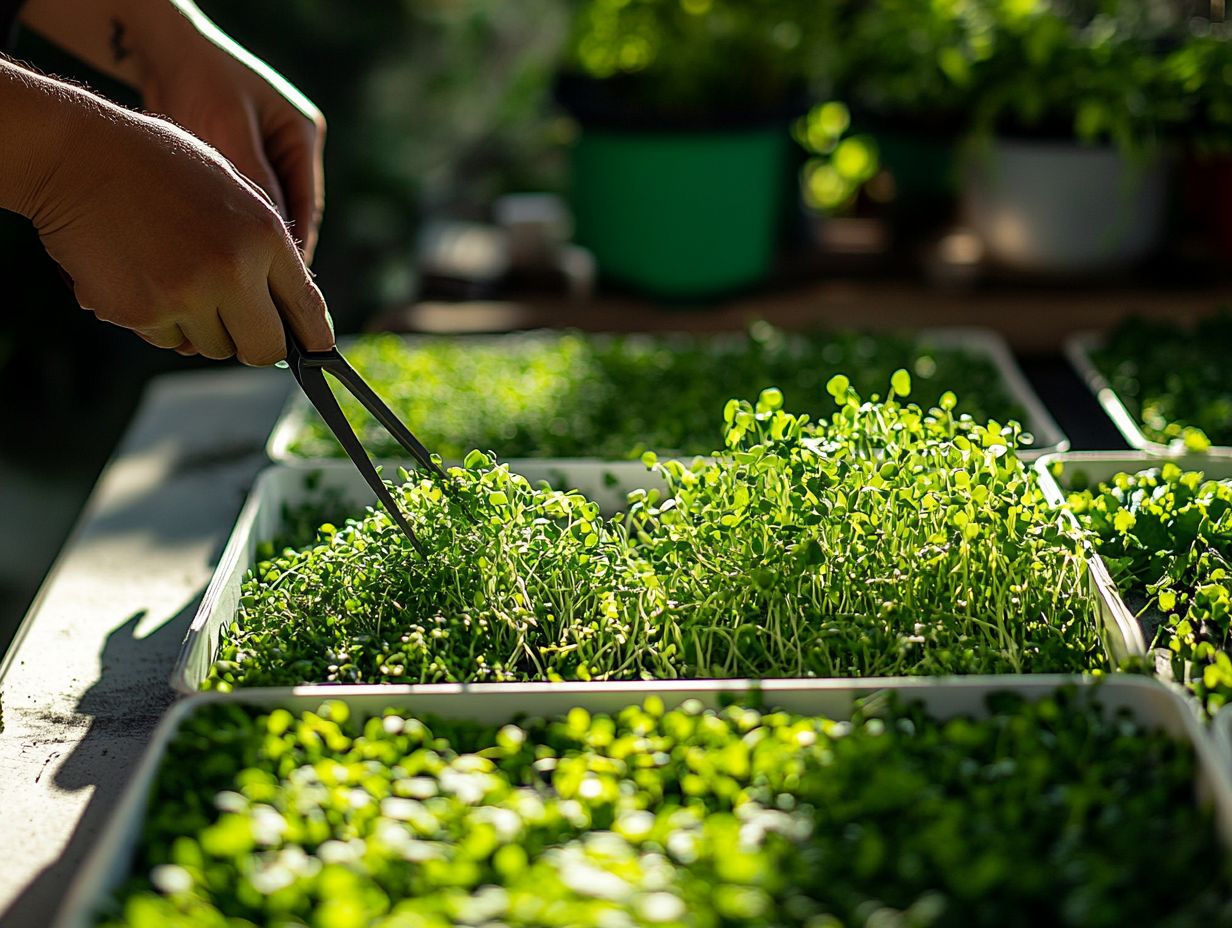
Following best practices while growing microgreens can significantly elevate both your crop yield and quality. It helps you sidestep common pitfalls that often lead to plant failure. Ensure your plants receive adequate sunlight, maintain a proper watering schedule, and guarantee good soil quality to promote healthy growth.
Selecting the right seeds is essential. Opting for organic varieties typically results in healthier crop development. Many beginners underestimate the importance of light management, sometimes placing their plants in low-light areas or failing to provide consistent exposure. Utilizing grow lights can help you deliver the necessary intensity without the risk of overheating.
Avoid overwatering. Monitor your soil moisture and allow it to dry slightly between waterings. This prevents root rot and encourages robust growth. By integrating these practices, you can refine your approach and enjoy a more fruitful harvest.
Start your own microgreen garden today and discover the joy of growing and cooking with these nutritious greens!
Storing and Preserving Microgreens
Properly storing and preserving microgreens is crucial for maintaining their freshness and nutritional value. This allows you to savor these delightful greens for extended periods.
By utilizing effective techniques, you can ensure that your harvested microgreens, be it the delicate arugula or the robust broccoli, retain their vibrant flavors and textures until you’re ready to incorporate them into your next culinary creation. For more tips, check out this guide on how to grow microgreens in a small space.
Methods for Keeping Microgreens Fresh
To keep your microgreens fresh, employ techniques that effectively manage how wet or dry they are and temperature. This ensures they remain crisp and flavorful for as long as possible.
Consider storing them in airtight containers and using damp paper towels to maintain their texture and prevent wilting.
If you wash your microgreens before storage, it’s essential to dry them thoroughly to remove any excess moisture that could encourage mold growth. The ideal storage temperature for these delicate greens falls between 32 F and 40 F, making your refrigerator, especially the crisper drawer, an excellent choice. For more on caring for your microgreens, consider checking out timing your microgreens: when to harvest?
Pay attention to environmental factors like light exposure; keeping them in a dark area can help slow down deterioration. Regularly check for signs of spoilage, such as yellowing or sliminess, so you can consume or dispose of them promptly, ultimately extending their lifespan.
Frequently Asked Questions
What are microgreens?
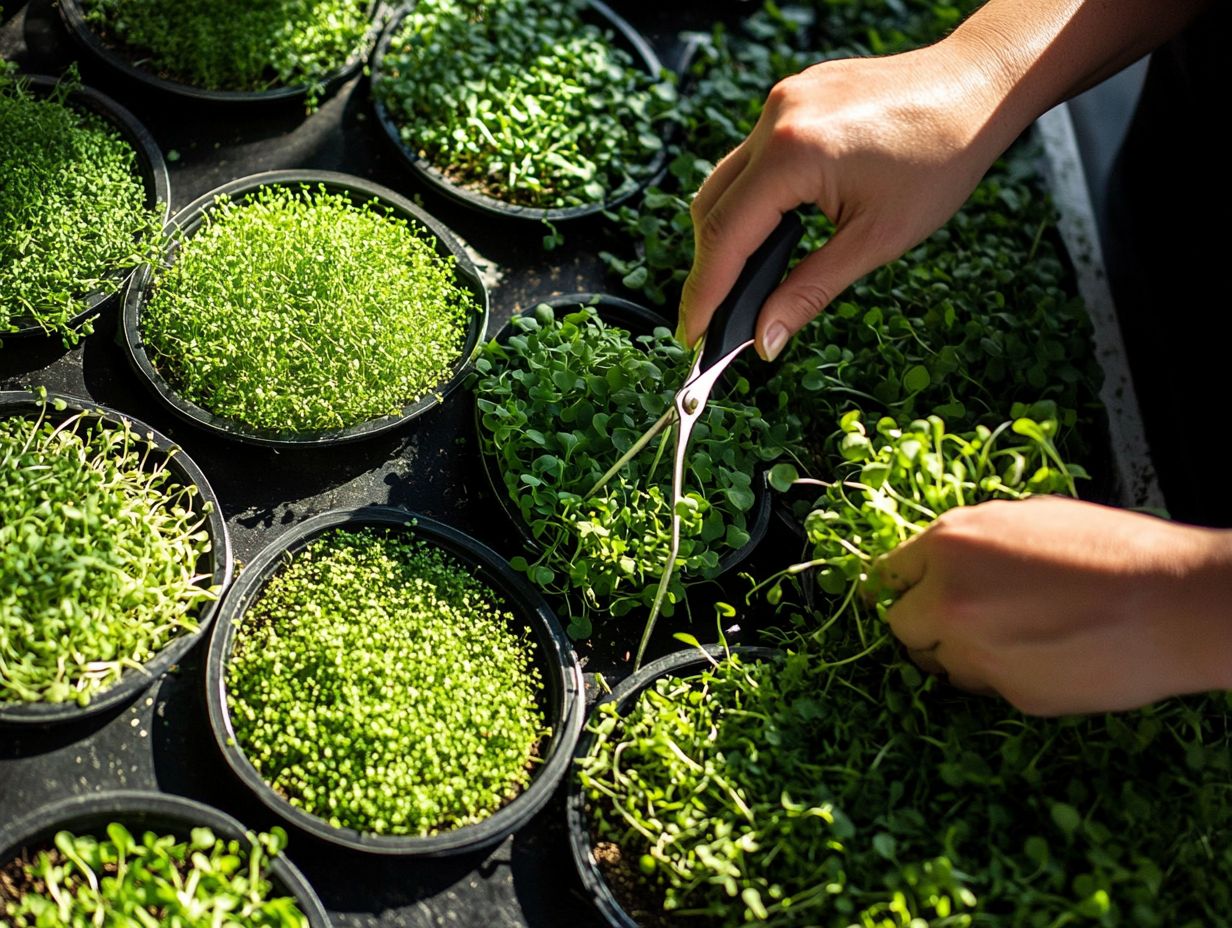
Microgreens, such as kale, radish, and arugula, are small, edible plants harvested at an early growth stage. They are packed with nutrients and add flavor and texture to your dishes.
Why should I grow microgreens for cooking?
Growing microgreens means you can enjoy fresh, nutritious greens right in your meals. They are also easy to grow and can be harvested multiple times.
When is the best time to harvest microgreens?
The best time to harvest microgreens is when they have reached the ideal growth stage, typically when they have their first set of true leaves and are around 1-2 inches tall. This applies to types such as beet and broccoli.
How do I prepare microgreens for cooking?
To harvest microgreens, use a clean pair of scissors or a sharp knife to cut the greens just above the soil line. Rinse them gently and pat dry before using them in your dishes.
Can I store harvested microgreens?
Keep your microgreens fresh and delightful by storing them in the fridge! Just pop them in a sealed container or bag. However, they are best enjoyed fresh and should be used within a day or two of harvesting.
Excited to use your harvested microgreens? Here are some delicious ideas!
Harvested microgreens can be used as a garnish, added to salads, sandwiches, soups, or used as a topping for pizzas and omelettes. They can also be blended into smoothies or juiced for a nutrient boost.

